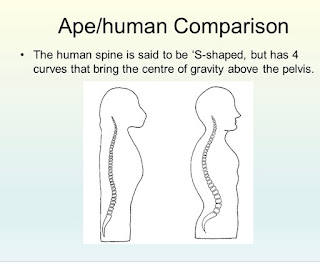Skip to main content
Bipedalism? The spine?
The most common skeletal elements associated with bipedalism are generally the lower limbs, but now the spine can also be a factor in determining whether or not the remains in question walked upright. Erect bipedalism is one of the specialized characteristics associated with hominids and arose at least 4.4 million years ago, possibly more than 6 ma. Although, there is not one omnipresent model of the acquisition of human bipedalism anthropologists have been able to use the shape of a specimen's spine to help determine their bipedal abilities.

Measurements taken off of an individual vertebrae can indicate the curvature of the whole column. All of the vertebrae from a the spine of a chimpanzee has a distinctive forward 'wedge' that attributes to their sloped posture. Whereas, the spine of a hominid or bipedal australopithecine have specific angles according to the location in the spine the vertebrae came from (i.e. anterior wedging in the thoracic region and posterior wedging in the lumbar and cervical region). An orthograde trunk (the torso and spine stand vertically) over extended lower limbs is characteristically human, though many vertebrates have waked or do walk bipedally, humans are the only ones to acquire habitually erect bipedalism. This information combined with what is known about other skeletal elements associated with this trait can help to confirm or deny whether a specimen exhibited erect bipedalism.


Great! I like how in depth you went here. It will be interesting to see how these data compare to later hominins and if we can tell that later australopiths were more upright than earlier ones. Keep up the good work and see if you can find more evidence of how the spine changes over time!
ReplyDeleteJust some extra articles I found on this topic: https://www.ncbi.nlm.nih.gov/pmc/articles/PMC4410577/#:~:text=Since%20bipedalism%20causes%20a%20large,during%20bipedal%20posture%20and%20locomotion.
ReplyDeletehttps://www.jdao-journal.org/articles/odfen/pdf/2015/02/odfen140051.pdf
these are great!!! thanks for sharing! I really love papers like the second one you posted from outside of anthropology cause they have such a different method of talking about these things!
ReplyDelete